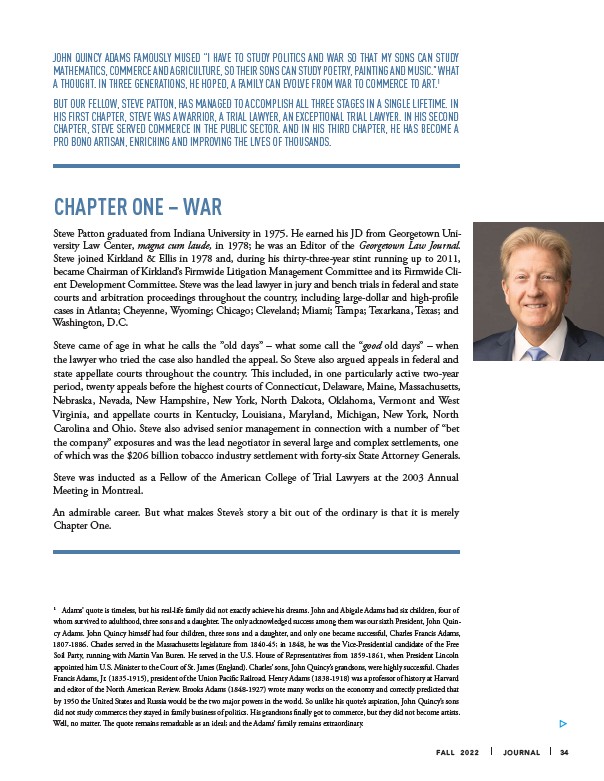
JOHN QUINCY ADAMS FAMOUSLY MUSED “I HAVE TO STUDY POLITICS AND WAR SO THAT MY SONS CAN STUDY
MATHEMATICS, COMMERCE AND AGRICULTURE, SO THEIR SONS CAN STUDY POETRY, PAINTING AND MUSIC.” WHAT
A THOUGHT. IN THREE GENERATIONS, HE HOPED, A FAMILY CAN EVOLVE FROM WAR TO COMMERCE TO ART.1
BUT OUR FELLOW, STEVE PATTON, HAS MANAGED TO ACCOMPLISH ALL THREE STAGES IN A SINGLE LIFETIME. IN
HIS FIRST CHAPTER, STEVE WAS A WARRIOR, A TRIAL LAWYER, AN EXCEPTIONAL TRIAL LAWYER. IN HIS SECOND
CHAPTER, STEVE SERVED COMMERCE IN THE PUBLIC SECTOR. AND IN HIS THIRD CHAPTER, HE HAS BECOME A
PRO BONO ARTISAN, ENRICHING AND IMPROVING THE LIVES OF THOUSANDS.
CHAPTER ONE – WAR
Steve Patton graduated from Indiana University in 1975. He earned his JD from Georgetown University
Law Center, magna cum laude, in 1978; he was an Editor of the Georgetown Law Journal.
Steve joined Kirkland & Ellis in 1978 and, during his thirty-three-year stint running up to 2011,
became Chairman of Kirkland’s Firmwide Litigation Management Committee and its Firmwide Client
Development Committee. Steve was the lead lawyer in jury and bench trials in federal and state
courts and arbitration proceedings throughout the country, including large-dollar and high-profile
cases in Atlanta; Cheyenne, Wyoming; Chicago; Cleveland; Miami; Tampa; Texarkana, Texas; and
Washington, D.C.
Steve came of age in what he calls the ”old days” – what some call the “good old days” – when
the lawyer who tried the case also handled the appeal. So Steve also argued appeals in federal and
state appellate courts throughout the country. This included, in one particularly active two-year
period, twenty appeals before the highest courts of Connecticut, Delaware, Maine, Massachusetts,
Nebraska, Nevada, New Hampshire, New York, North Dakota, Oklahoma, Vermont and West
Virginia, and appellate courts in Kentucky, Louisiana, Maryland, Michigan, New York, North
Carolina and Ohio. Steve also advised senior management in connection with a number of “bet
the company” exposures and was the lead negotiator in several large and complex settlements, one
of which was the $206 billion tobacco industry settlement with forty-six State Attorney Generals.
Steve was inducted as a Fellow of the American College of Trial Lawyers at the 2003 Annual
Meeting in Montreal.
An admirable career. But what makes Steve’s story a bit out of the ordinary is that it is merely
Chapter One.
1 Adams’ quote is timeless, but his real-life family did not exactly achieve his dreams. John and Abigale Adams had six children, four of
whom survived to adulthood, three sons and a daughter. The only acknowledged success among them was our sixth President, John Quincy
Adams. John Quincy himself had four children, three sons and a daughter, and only one became successful, Charles Francis Adams,
1807-1886. Charles served in the Massachusetts legislature from 1840-45; in 1848, he was the Vice-Presidential candidate of the Free
Soil Party, running with Martin Van Buren. He served in the U.S. House of Representatives from 1859-1861, when President Lincoln
appointed him U.S. Minister to the Court of St. James (England). Charles’ sons, John Quincy’s grandsons, were highly successful. Charles
Francis Adams, Jr. (1835-1915), president of the Union Pacific Railroad. Henry Adams (1838-1918) was a professor of history at Harvard
and editor of the North American Review. Brooks Adams (1848-1927) wrote many works on the economy and correctly predicted that
by 1950 the United States and Russia would be the two major powers in the world. So unlike his quote’s aspiration, John Quincy’s sons
did not study commerce; they stayed in family business of politics. His grandsons finally got to commerce, but they did not become artists.
Well, no matter. The quote remains remarkable as an ideal; and the Adams’ family remains extraordinary.
FALL 2022 JOURNAL 34